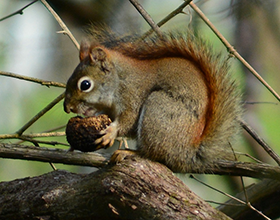 Going nuts! A good year for walnuts — and squirrels.
Going nuts! A good year for walnuts — and squirrels.
These days, every squirrel seems to have a nut in its mouth. And if you walk in the woods, it’s hard not to notice the crunch of acorns underfoot, or the periodic crash of walnuts dropping like bombs from the treetops. These events signal the ripening of the local mast crops. Many of Ohio’s tree species produce fruits and nuts. Fleshy fruits like crabapples, pawpaws, and black cherries are known as “soft mast” crops; many of these ripen during summer or early autumn, and they substantially decay through the course of those seasons. In contrast, hard-shelled nuts like acorns, beech nuts, walnuts, and hickory nuts — so-called “hard mast” – tend to ripen later, and their protective shells allow them to persist through the winter. Hard mast fruits may be tough on the outside, but the inner flesh is rich in nutrients and calories. As such, hard mast provides critical food for woodland animals through the cold, when other foods like insects and fresh plants are unavailable.
Although black walnuts and red oak acorns litter the ground this year, that’s not the case every year. “Mast years,” with abundant crops of nuts, occur every few years, with different cycles for different tree species. Interestingly, mast years are not a feature of individual trees. Rather, they tend to be synchronized across forests or geographic areas. Scientists still are not certain about the explanation for these patterns: what is it that triggers a mast year, and what generates the geographic synchrony? The most obvious explanation is climate; particular conditions of temperature or precipitation may induce particular species to produce fruit. Researchers also postulate that trees may “communicate” with each other to synchronize, through chemical signals transmitted across their roots or leaves.
This strategy of variable productivity probably helps the trees to secure their reproduction. Many mast fruits are infested with pests, rot on the forest floor, or are eaten by animals. Producing huge crops in selected years may assure that at least some nuts survive to germinate and produce new trees.
In years when mast crops are abundant, the animals that eat those crops likewise thrive. Deer, squirrels, chipmunks, mice, turkeys, and other animals are better able to survive and proliferate in years with rich winter food supplies. In turn, organisms that rely on those consumers — hawks that eat squirrels, or ticks that live on mice, for example — also thrive in parallel. The cycle of nuts substantially drives the dynamics of the ecosystem.
So, if you’re walking in the woods, beware of falling walnuts! And in the year ahead: be on the lookout for a lot of squirrels.
